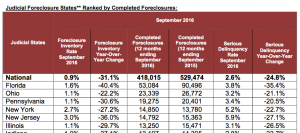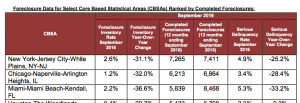From CNBC:
What’s behind a sudden foreclosure spike
Foreclosures had been falling steadily to the lowest levels in nine years, but a curious spike in October may be the first sign of a crack in the recovery.
The number of properties with a foreclosure filing, which includes default notices, scheduled auctions and bank repossessions, jumped 27 percent in October compared with September, according to a new report from Attom Data Solutions. The volume is still down 8 percent from a year ago, but annual drops had been in the double digits all year, until now. Government-insured FHA loans are fueling much of the jump.
“While some states are still slogging through the remnants of the last housing crisis, the foreclosure activity increases in states such as Arizona, Colorado and Georgia are more heavily tied to loans originated since 2009 — after most of the risky lending fueling the last housing boom had stopped,” said Daren Blomquist, senior vice president at Attom Data Solutions.
“The increase in October isn’t enough evidence to indicate a new foreclosure crisis emerging in these states, but it certainly demonstrates that this housing recovery is not completely devoid of risk.”
The spike, the biggest monthly jump since August 2007, may be due to a dynamic in the recovery itself: When the mortgage market crashed, and private capital fled entirely, the government stepped in. Government-insured FHA loans jumped from about 3 percent of mortgage originations in 2005 to as high as 18 percent in 2010, according to Inside Mortgage Finance.These loans, which require just a 3.5 percent down payment, are by definition more risky. Not only do borrowers have far less of a cushion in prices, but the credit score minimum is lower. Borrowers who use FHA loans, which require mortgage insurance, are likely doing so because don’t have the income to afford a higher down payment.
“In digging into the numbers among loans that were originated in the seven years from 2009 to 2015, FHA and VA loans account for 49 percent of all active loans in foreclosure. By comparison, among loans in that were originated in the previous seven years from 2002 to 2008, FHA and VA loans account for just 12 percent of all active loans in foreclosure. Most of the risk during that time was subprime, which were exotic loan products outside of the FHA and VA credit box,” said Blomquist.


